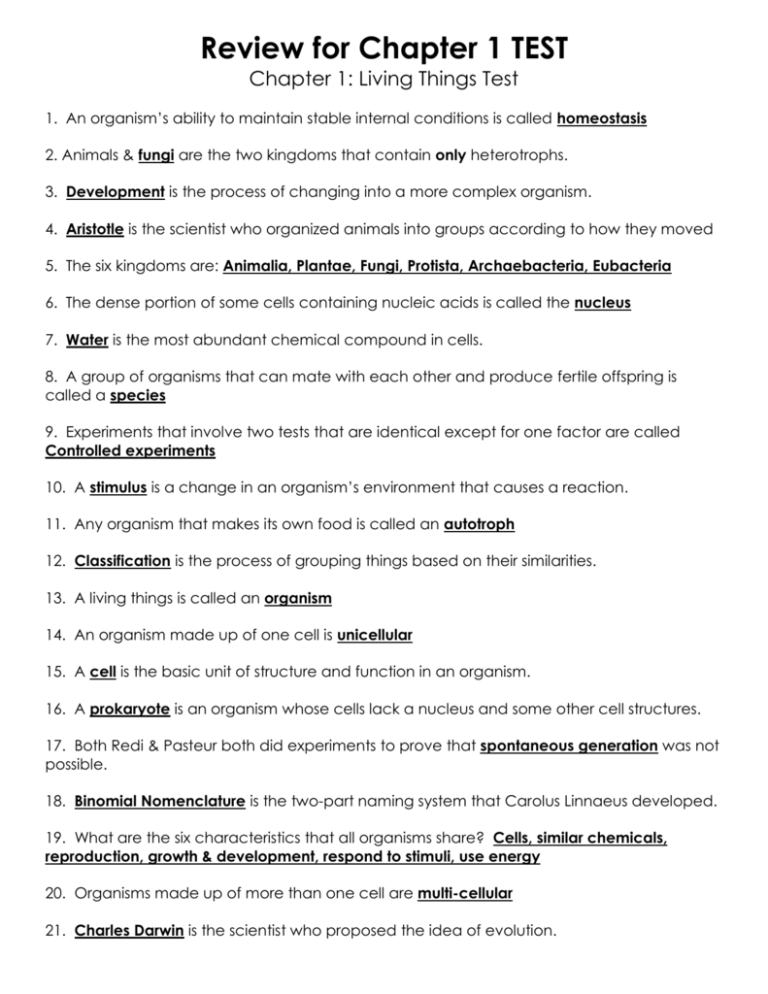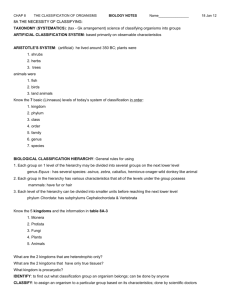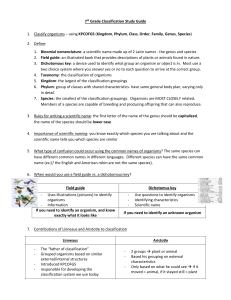Name
advertisement

Review for Chapter 1 TEST Chapter 1: Living Things Test 1. An organism’s ability to maintain stable internal conditions is called homeostasis 2. Animals & fungi are the two kingdoms that contain only heterotrophs. 3. Development is the process of changing into a more complex organism. 4. Aristotle is the scientist who organized animals into groups according to how they moved 5. The six kingdoms are: Animalia, Plantae, Fungi, Protista, Archaebacteria, Eubacteria 6. The dense portion of some cells containing nucleic acids is called the nucleus 7. Water is the most abundant chemical compound in cells. 8. A group of organisms that can mate with each other and produce fertile offspring is called a species 9. Experiments that involve two tests that are identical except for one factor are called Controlled experiments 10. A stimulus is a change in an organism’s environment that causes a reaction. 11. Any organism that makes its own food is called an autotroph 12. Classification is the process of grouping things based on their similarities. 13. A living things is called an organism 14. An organism made up of one cell is unicellular 15. A cell is the basic unit of structure and function in an organism. 16. A prokaryote is an organism whose cells lack a nucleus and some other cell structures. 17. Both Redi & Pasteur both did experiments to prove that spontaneous generation was not possible. 18. Binomial Nomenclature is the two-part naming system that Carolus Linnaeus developed. 19. What are the six characteristics that all organisms share? Cells, similar chemicals, reproduction, growth & development, respond to stimuli, use energy 20. Organisms made up of more than one cell are multi-cellular 21. Charles Darwin is the scientist who proposed the idea of evolution. 22. Organisms are placed into kingdoms by number of cells, types of cells, ability to make food 23. Louis Pasteur did an experiment where he boiled broth in a flask to prove that bacteria do not appear unless there is existing bacteria. 24. Scientists classify organisms to help them organize living things. 25. Organisms that can’t make their own food are called heterotrophs 26. Evolution is the process by which species gradually change over time. 27. Organisms with cells that contain nuclei are called Eukaryotes 28. An action or change in a behavior that is a result of a stimulus is a response 29. Taxonomy is the study of how to classify living organisms. 30. Archaebacteria and eubacteria are unicellular, prokaryotes. (T) 31. Scientists have not made any changes to the way we classify in 250 years. (F) scientists have made many changes to classification basing most on fossil evidence & DNA 32. Some organisms do not fit neatly into any category (T) 33. Miller & Urey modelled the conditions of early earth’s atmosphere in their 1953 experiment proving abiogenesis. (T) 34. Scientists use Latin names to communicate with other scientists. (T) 35. In binomial nomenclatures, the genus & species names are capitalized. (F) The genus is capitalized, while the species is lower case 36. Species with similar evolutionary histories are classified more closely together. (T) 37. When scientists perform a controlled experiment they set up 2 experiments and change 2 or more things in the 2nd experiment. (F) Only 1 thing is changed in the 2nd experiment Directions: Answer as completely as possible. 1. What are the 7 levels of classification? (Start with the broadest) KingdomPhylumClassOrderFamilyGenusspecies 2. How is an organism’s evolutionary history related to the way in which it is classified? Fossil evidence, development & DNA are all used to show relationship. The more a species has in common, the closer related they are. 3. What is a dichotomous key? A dichotomous key is a series of paired statements describing a physical characteristic allowing the user to positively identify an unknown organism 4. How do growth & development differ? Growth: get bigger; development: gain more skills/abilities 5. All living things need 4 things to stay alive. List these: (hint…pages 20-23) Living things need water, energy, living space, & stable internal conditions to remain alive 6. What do scientists theorize the conditions of earth were like 3.6 billion years ago? Early Earth’s conditions were not hospitable. There was no free oxygen in the air and it was windy, stormy, lightning & extremely hot, not plants, … 7. What were the three major groups of animals in Aristotle’s system of classification? Those that could fly, those that could swim, those that could walk, run, crawl 8. Using the chart on page 33, what levels do the Robin & the Great Horned Owl share? KingdomPhylumClass 9. Which part of the scientific name is like your first name? species. Your last name? Genus.









